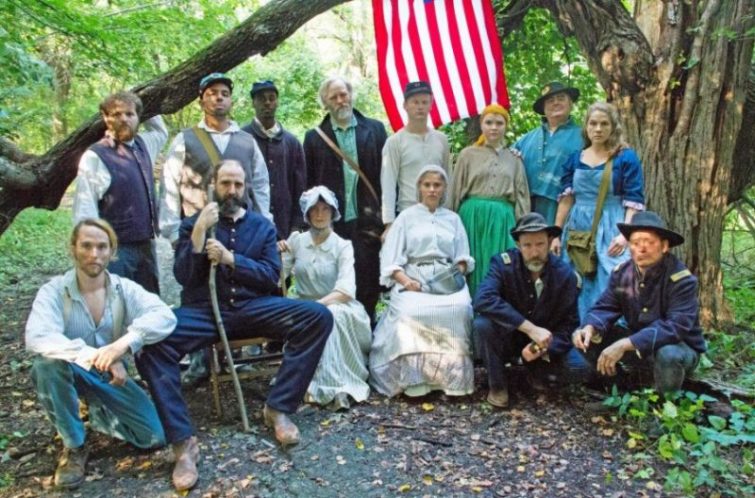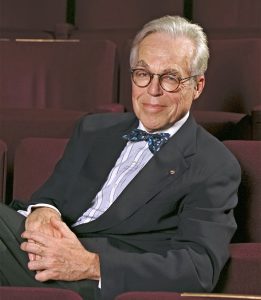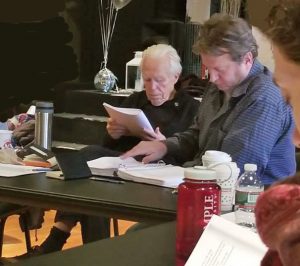
The Lydie Breeze Trilogy is the pinnacle in the career of playwright John Guare, best known for The House of Blue Leaves and Six Degrees of Separation. Film director Louis Malle said that Guare’s plays “take us to the core of human suffering: the awareness of corruption in our own bodies, death circling in.”
With Guare about to turn 80, it’s odd that his creation has never been performed as he intended, as a trilogy.  EgoPo Classic Theater is presenting the world premiere production of the complete trilogy in Philadelphia, with original music by Cynthia Hopkins and Jay Ansill. The staging will unfold over three months (February to May), individually and also in three consecutive evenings, and in a single-day experience with meal breaks.
EgoPo Classic Theater is presenting the world premiere production of the complete trilogy in Philadelphia, with original music by Cynthia Hopkins and Jay Ansill. The staging will unfold over three months (February to May), individually and also in three consecutive evenings, and in a single-day experience with meal breaks.
The founder of EgoPo is Lane Savadove, age 50. When Savadove was working as an associate director at the Guthrie Theater in Minneapolis in 1999, that company staged a Guare play and Savadove, in preparation, read everything that Guare had published. He was blown away by the power of the Lydie Breeze plays. By happenstance, the following year the New York Theatre Workshop mounted parts 2 and 3 of the trilogy and the playwright invited Lane to work with him on those productions.
Those two plays did not gain great reviews, and Savadove believes it’s because they work best when seen after the first part, which he describes as “a hidden treasure.” The Arena Stage 1985 production of the first part was directed by Douglas C. Wager — now Associate Dean of Theater at Temple University — with puppets devised by Julie Taymor, but the company did not follow it with the other parts of the epic.
 “Together,” says Savadove, “they are a giant sweeping epic that joins a personal spiritual journey with the landscape of American history. They are heartfelt and vulnerable while containing soaring theatrical lyricism. It hit me that John had created a new American Expressionism that carried forward the legacy of Tennessee Williams and early Eugene O’Neill.”
“Together,” says Savadove, “they are a giant sweeping epic that joins a personal spiritual journey with the landscape of American history. They are heartfelt and vulnerable while containing soaring theatrical lyricism. It hit me that John had created a new American Expressionism that carried forward the legacy of Tennessee Williams and early Eugene O’Neill.”
The trilogy is a multi-decade drama with a poetic overview of how America developed between the Civil War and the 20th century. One of the most fascinating aspects is how Guare’s form and style changes with the content. The first play, originally named Women and Water and now named Cold Harbor after the 1864 battles near Richmond Virginia, is an adventure story incorporating guns and sails, a melodrama with vaudeville elements. The second play, Aipotu, is named for a Utopian commune which the characters establish in New England after the war and has the form of intimate psychological realism. In the third play, Home, the next generation grapples with the crumbling foundation of their family and with the physical crumbling of their island into the sea, certainly causing us to think about the changes in topography caused by today’s global warming. The style of Home reflects the internal journeys of the participants and is displayed with fantastical expressionism.
To set the scene, in Cold Harbor General Ulysses S. Grant orders waves of men to charge to their deaths, while nurse Breeze collects their valuables to deliver to their loved ones back home. Lydie and friends forge a vision for a new life and a new America after the conflict. The cast numbers 24. Then a dramatic shift occurs at the start of Aipotu, which employs a cast of only four to relate the intimate core of its content.
All in all, Savadove rates Guare’s work on a level with Edward Albee as American poetic theater. The playwright and the director were together in Philadelphia during rehearsals, editing the scripts to tie the three plays closer together.
EgoPo is an appropriate company to be tackling the diversity of the Lydie Breeze trilogy because it combines various schools of theatrical expression. It appears to be a natural fit. Savadove grew up in Pennsylvania and graduated from Haverford College in 1989, then worked in New York, San Francisco, Europe and New Orleans. The avant-garde theater company was founded by Savadove in 1991 and moved to New Orleans in 2002. He directed twelve productions in New Orleans and trained close to a hundred young people in his unique style. After the 2005 flooding of New Orleans by Hurricane Katrina, the company relocated to Philadelphia.
EgoPo has an innovative approach to theater classics, believing that listening to the body and following its impulses leads an actor to emotional truth. The company’s slogan is “emotions are born of the body.” The company name combines the ego, or self, with the French word for skin, peau, re-spelled. You might say, the physical self.
Guare says, “The plays are about a band of people who are thrown together in war, and the four actors in the principal roles with EgoPo have all worked together before and know each other so well that they have that quality of love and intimacy among them.”
In the company’s Lydie Breeze ensemble the actors must also sing, and play musical instruments. “My work is raw, emotional and expressive,” says Savadove; “We use a kind of training and a kind of work that’s different from others.” Savadove says it normally takes an actor a year to fully get this technique, with rigorous physical training being essential.
Savadove uses Viewpoints, a training technique based on modern dance, developed by choreographer Mary Overlie and directors Anne Bogart and Tina Landau. “But I meld Viewpoints with Grotowski,” says Savadove, referring to the Polish teacher and director who brought his methods to New York in the 1970s. He wanted his actors to bare their souls and expose themselves to the audience. Savadove compares him to the choreographer Martha Graham because of his intensity of personal expression: “He asks actors to share the secret parts of themselves with the audience. Grotowski says open all movement possibilities and you’ll free up feelings that have been suppressed.” Grotowski’s weakness is that the actor sometimes can be so focused on his emotions that he loses his relationship with space and with the other performers.
Viewpoints, on the other hand, can be likened to choreographer Merce Cunningham. It stresses the relationships of bodies and the architecture of space. Savadove incorporates elements from these two methods.
Clearly, the diversity of Lydie Breeze’s three parts requires a variety of stylistic approaches. Opening night for the first part of Lydie Breeze is February 2, and the trilogy climaxes with marathons on April 28, 29, May 5 and 6. See https://www.egopo.org/
Below, Guare and Savadove at a rehearsal:
